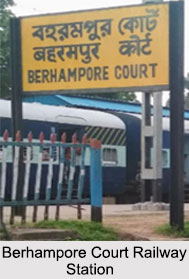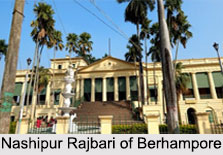 The city of Berhampore is located on the eastern side of the Bhagirathi River, a major distributary of the Ganga River. Berhampore is located about 200 km north of Kolkata and has an average elevation of 59 feet.
The city of Berhampore is located on the eastern side of the Bhagirathi River, a major distributary of the Ganga River. Berhampore is located about 200 km north of Kolkata and has an average elevation of 59 feet.
History of Berhampore
The city of Berhampore has a long history enriched by the Nawabs and Sultans of Bengal, Zamindar and other European colonial forces such as Dutch, Portuguese, British and French. In 1757, the city of Berhampore was fortified by the East India Company and after the Battle of Plassey in June 1757; the city continued being a cantonment until the year 1870. The foundation of the city still remains questionable. The cantonment was constituted as a municipality in 1876 and was the headquarters of Murshidabad district. The Berhampore College was founded in 1853 and in 1888 it was transferred over to a local committee, mainly supported by Rani Swarnamayi. It is also known that the Sepoy Mutiny of 1857 took place in the Barrack Square of Berhampore, while it was still under the rule of Raja Krishnath and his ancestors.
Demographics of Berhampore
As per the reports of the Census India 2011, the total population of the city is 1, 95,223 out of which the male and female are 1, 00,247 and 94,976 respectively. The population of children between 0 to 6 years is 23,182.
Economics of Berhampore
The geographic location of the city increased its importance and now it is a business hub. Due to its historical importance, this city also earns a good number of tourists, thus making tourism a prominent industry there. There is a neighbourhood in Berhampore called Khagra which is renowned for its manufacture of bell metal and brass utensils, as well as ivory and wood carving. A famous type of metal used to make bells called "Khagrai Kansha" is made in the city. This is a type of brass that is used to make utensils like dishes & bowls. The major industries in Khagra mostly include agricultural related industries like rice and oil-seed milling.
The city of Berhampore is also known for its Murshidabadi silk, which is famously known as tassar silk. It is also known for its sweets like the chhanabora, the savoury khaja and the delectable manohara.
Culture of Berhampore
Berhampore is known for its elegant pieces of handicrafts namely the making of carpet, bamboo and jute crafts, and miniature paintings. The city used to be under the patronage of Nawabs, so there have always been a spark of culture and heritage from this place. The artists from various field of arts sowed the seed of cultural heritage in this place. The calm lifestyle of this city still evokes a rich cultural environment. Berhampore can be considered as one of the main cultural hubs of West Bengal. There are renowned theatre groups that organise theatre festivals throughout the year mostly during the winter season.
Nearby Attractions of Berhampore
Berhampore is a famous place for tourists in West Bengal and listed below are some of the places that are popular among the tourists.
 Nashipur Rajbari: Referred to as the "princely abode" by Lord Curzon, the Nashipur Rajbari is a grand palace, which used to be the court of Debi Singha who is historically renowned for being the tax collector under the British. The palace is often referred to as a miniature version of the Hazarduari Palace of Murshidabad due to its similar features. The most important festival held here is the fair of Jhulan Yatra, also known as Raksha Bandhan, which is held every year for a maximum of five days in the month of August and ends on Rakhi Purnima. People from far off assemble here to be a part of the fun and merriment on this auspicious occasion.
Nashipur Rajbari: Referred to as the "princely abode" by Lord Curzon, the Nashipur Rajbari is a grand palace, which used to be the court of Debi Singha who is historically renowned for being the tax collector under the British. The palace is often referred to as a miniature version of the Hazarduari Palace of Murshidabad due to its similar features. The most important festival held here is the fair of Jhulan Yatra, also known as Raksha Bandhan, which is held every year for a maximum of five days in the month of August and ends on Rakhi Purnima. People from far off assemble here to be a part of the fun and merriment on this auspicious occasion.
Kathgola Palace: Located in the Kathgola gardens, the Kathgola Palace is a four storied palatial palace. It has an ornamented facade with valuable paintings, mirrors and priceless furniture. Beside the palace there is a small pond and a steep-well.
Fauti Masjid: It is a mosque in the city of Kumarpur, which is at a mere distance of 12.5 km from Berhampore. The Fauti Masjid is one of the largest mosques in the town of Kumarpur. Built in 1740 AD by Nawab Sarfaraz Khan, the mosque is 135 feet in length and 38 feet in width.
Khushbagh: The name itself means the Garden of Happiness and is known to be the garden cemetery of the family of the Nawabs of Bengal. Located on the western bank of the Bhagirathi River, the garden is known to be the resting place of Nawab Siraj ud-Daulah. There was a time, when the garden had about 108 varieties of roses which was well tended to by Lutf-un-nisa, the wife of Siraj ud-Daulah"s.
The other places of interest are the Jafarganj Cemetery, Krishnath College and the home of Jagat Seth, who were a rich business, banking and money lender family during the time of Sirajud-Daulah.
Visiting Information on Berhampore
Berhampore has its own railway station called the Berhampore Court Railway station and is on the Sealdah-Lalgola line of the Eastern Railway. Berhampore is about 186 km away from the city of Kolkata via trains. The city of Berhampore is also well connected via roadways by National Highway 12 and 34.



















